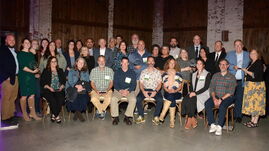
Whatever works: Reinventing the office for a post-COVID world
 Photo / Tim Greenway
Workers’ comp provider MEMIC is bringing employees back to the office in phases with new safety and cleaning protocols in place, says Catherine Lamson, senior vice president and chief administrative officer.
Photo / Tim Greenway
Workers’ comp provider MEMIC is bringing employees back to the office in phases with new safety and cleaning protocols in place, says Catherine Lamson, senior vice president and chief administrative officer.
“If you touch it, wipe it,” is the new office mantra at the MEMIC Group, a Portland-based workers’ compensation insurance provider that’s starting to bring employees back to the office after four months of remote work.
Led by President and CEO Michael Bourque, the 500-employee firm occupies two buildings in Portland that it owns and leases regional offices in seven East Coast cities.
Still in Phase 2 of its return plan, MEMIC’s Portland anchor remains well shy of the 40% staff level it determined can safely be inside at this time. Looking a lot different than before the pandemic, MEMIC’s headquarters now have hand-sanitizer dispensers on every floor, new name badge and face-covering requirements and no more coffee machines for common use. Meeting rooms are also closed and everything is done on video.
“It’s not ideal but it works very well,” says Catherine Lamson, MEMIC’s senior vice president and chief administrative officer and part of the committee that put together the reentry plan and protocols.
Lamson, still working from home except when a task requires her to be in the office or to pick up mail, says that MEMIC has had remote workers for 25 years and had been looking to expand that long before the pandemic. She also says the company is starting to think about its long-term real estate needs.
“I don’t know if we’re going to reduce the footprint, but we are certainly not going to increase the footprint,” says Lamson. Noting that it’s too soon for detailed predictions, she adds: “We are prepared for however long this takes.”
MEMIC isn’t the only Maine employer grappling with COVID’s impact on the workplace, and its future office requirements. Another is Baker Newman Noyes, a 284-employee accounting firm with leased space in Portland and four other cities that remains empty as people work from home.
“We have learned a great deal about how to work effectively in a remote environment, and we expect our demands for square footage will decrease,” says the firm’s managing principal, Dayton Benway. “How much space we eventually need remains to be seen as the factors that will guide our decision-making are still a moving target.”

As Maine companies large and small think about reconstituting existing premises, finding new ones or planning to stay virtual forever after COVID-19, the implications for office real estate in Portland and beyond are huge. The health crisis is also fueling innovation in unexpected places, like the Holiday Inn by the Bay pitching its rooms as quiet places to work away from home.
“Typically, we’d be very busy this time of year,” says the hotel’s general manager, Annaliese Lafayette. During COVID, “we’ve been very slow and are trying to get creative to drive revenue.” She also says she thinks the hotel will offer the promotion after this year, and that it plans to rent its parking-garage rooftop event space long-term.
Accelerated evolution
It’s not just the real estate landscape that is changing in Portland and beyond, but also the perception of the workplace.
“What this virus has done is rip open many of the things that were wrong with the workplace,” says Lisa Whited, a Portland-based adviser on employee engagement and workplace strategy.
“The workplace is based on the Industrial Revolution model when workers had to go the factories,” she adds. “We’ve not changed that even though technology has allowed us to work anywhere in the world. This opportunity to shake things up is long overdue.”
While the work-from-home trend is not new, it has gained momentum during the pandemic — and there’s a definite economic incentive for employers in case of a protracted downturn.
“Regardless of whether or not we slide into another recession as a result of COVID-19, the experience will likely cause employers to rethink the ‘where’ and ‘how’ of work,” according to Kate Lister, president of San Diego-based Global Workplace Analytics, on her website. That’s backed by her own research, including a survey of close to 3,000 global office workers during COVID-19.
A separate report, published in June by McKinsey & Co., found that while flexible office space solutions held about 3% of the U.S. office market before the crisis, that share had been growing at 25% annually for the past three years.
That’s expected to increase significantly in the wake of COVID, with more than 800 so-called office-space decision makers at large companies surveyed by McKinsey predicting the percentage of time worked in main offices to go down by 12% and satellite offices by 9%, while so-called flexible office space will hold steady and work from home will increase from 20% of work time to 27%.
Those changes, the authors conclude, may not only improve how work is done but also lead to significant savings in areas such as rent, facilities operations and maintenance, which account for 10% to 20% of personnel-driven expenditures.
Their advice to employers: “Use this moment to break from the inertia of the past by dispensing with suboptimal old habits and systems … Ultimately, the aim of this reinvention will be what good companies have always wanted: a safe environment where people can enjoy their work, collaborate with their colleagues and achieve the objectives of their organizations.”
Technology companies including Facebook and Twitter are leading the work-from-home trend on the national front. And in early July Tokyo-based Fujitsu Ltd. joined their ranks, announcing a plan to encourage 80,000 office workers in Japan to primarily work from home for a “more empowering, productive and creative experience” and plans to halve its office space in the country over the next three years.
In the United States, 60% of employed people were working at home during the crisis, up from 25% a couple of years ago, according to a Gallup poll conducted in April. In a separate survey by McKinsey, eight out of 10 respondents said they enjoy working from home, with 41% saying they are more productive than before and 28% finding they are as productive.
‘Flipped on its head’
Several large Maine-based employers with a presence in other states are holding off on a return to the office for the time being. Besides Baker Newman Noyes, they include engineering firm Woodard & Curran, which employs 1,100 people nationwide; and Tilson, a network deployment and IT professional services firm with 543 employees, including 183 in Maine.

As much as Tilson CEO Joshua Broder misses being with the team in the office, he says he doesn’t anticipate a return this year, and only if two criteria are met.
“For us to reoccupy our offices it has to be safe enough that we don’t need to implement engineered controls and PPE in the office — we don’t have an appetite to take any safety risk in the office, and schools have to be operating largely in person so child care is not a problem for our employees,” he says.
He says he doesn’t anticipate the first set of criteria being met this year.
Similarly at global payments provider WEX Inc., most employees are expected to continue to work from home until 2021 though the firm remains committed to a planned $50 million operations center in Scarborough. A spokesman says that while it’s premature to talk about changes in the company’s office design or real estate footprint, its plans for Scarborough have not changed.
Peter Michaud, a partner in the Downs developer Crossroads Holdings LLC and managing partner for Maine Properties LLC, Southern Maine Remodeling and M&R Holdings, also says that WEX remains 100% committed to the project, which he expects to break ground in late fall.
Speaking more generally about the office market, Michaud says that while some marginal deals are getting pulled, out-of-state interest in coming to Portland as a safe haven from COVID-19 has increased dramatically in the last several weeks.
“If someone wants a fancy office and nice views of Portland harbor that was great,” he says. “Now it’s going to be, ‘that view’s nice, but is the whole facility safe?’ It’s really been flipped on its head.”
Real estate brokers also expect the market to be in flux for some time.
“Just like people are attracted to Portland because of the retail, they are attracted to Portland as an office destination because of its restaurants and shopping,” says Peter Harrington, a partner and associate broker with Malone Commercial Brokers. “I do think this is an opportunity for people who have been thinking of trying to come to the Portland market. I wouldn’t be surprised if we saw companies from major metropolitan areas like New York or Boston consider moving to Maine.”

Justin Lamontagne, a partner and broker with NAI The Dunham Group, says that’s already having an effect though it’s too early to pin down current office vacancy rates in Portland.
“Anecdotally, there certainly seems to be significantly more office space on the market today than this time last year, and that’s true for both the suburbs and downtown Portland,” he says.
He adds, “This pandemic is an opportunity for businesses to take a hard look at their real estate needs and commitment to office interaction. Depending on the industry or specific employee role, many office professionals will never come back to physical bricks and mortar. But many other businesses are realizing the loss of connectivity and collaboration far outweigh the cost of office space.”














0 Comments